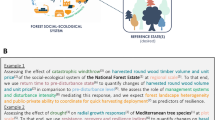Abstract
Forest management and planning can involve large tracts of land involving numerous areal units. One approach to plan activities for a forested region over decades involves breaking down decision making into three components: strategic, tactical, and operational. Each level of the management hierarchy can involve the development and application of optimization models. These models typically aid in exploring management alternatives as well as multi-objective tradeoffs. Even though a strategic model can provide support for long term management at a broad scale, solutions may not be feasible at an operational level. Tactical level modeling helps to bridge solutions reached at a strategic level using operational planning information. This paper presents several tactical level planning models that have been developed as a part of a research effort supported by the US Forest Service. These models have been utilized in land use management and planning by the US Forest Service through a specially developed spatial decision support system.
Similar content being viewed by others
References
K. Barber, Large FORPLAN models: an exercise in folly, in: Lessons from Using FORPLAN, USDA Forest Service, Land Management Planning, Washington DC (1986).
B.B. Bare and R. Field, An evaluation of FORPLAN from an operations research perspective, USDA Forest Service General Technical Report RM-140, Fort Collins, CO (1987).
B. Carroll, V. Landrum and L. Pious, Timber harvest scheduling with adjacency constraints: using ARC/INFO to make FORPLAN realistic, in: 1995 ESRI User Conference Proceedings, Redlands, California, USA (1995), available via http://www.esri.com/base/common/userconf/proc95/ prochome.html.
R. Church and K. Barber, Dissaggregating forest management plans to treatment areas, in: Stand Inventory Technologies 92, Portland, Oregon (1992) pp. 287–295.
R. Church, D. Lanter and S. Loban, VIP: a spatial decision support system for the US Forest Service, Working paper, Department of Geography, University of California, Santa Barbara, CA (1992).
R. Church, A. Murray and K. Barber, Designing a hierarchical planning model for USDA Forest Service planning, in: Proceedings of the 1994 Symposium on Systems Analysis and Forest Resources (1994) pp. 401–409.
R. Church, A. Murray, M. Figueroa and K. Barber, Support system development for forest ecosystem management, European Journal of Operational Research (1998), to appear.
K.N. Johnson and T. Stuart, FORPLAN Version 2: Mathematical Programmer's Guide, Land Management Planning Systems Section, US Forest Service, Washington, DC (1987).
B. Kent, B.B. Bare, R. Field and G. Bradley, Natural resource land management planning using large-scale linear programs: the USDA Forest Service experience with FORPLAN, Operations Research 39 (1991) 13–27.
J. Nelson, J.D. Brodie and J. Sessions, Integrating short-term, area-based logging plans with longterm harvest schedules, Forest Science 37 (1991) 101–122.
A. Weintraub and A. Cholaky, A hierarchical approach to forest planning, Forest Science 37 (1991) 439–460.
Author information
Authors and Affiliations
Rights and permissions
About this article
Cite this article
Church, R.L., Murray, A.T. & Barber, K.H. Forest planning at the tactical level. Annals of Operations Research 95, 3–18 (2000). https://doi.org/10.1023/A:1018922728855
Issue Date:
DOI: https://doi.org/10.1023/A:1018922728855




